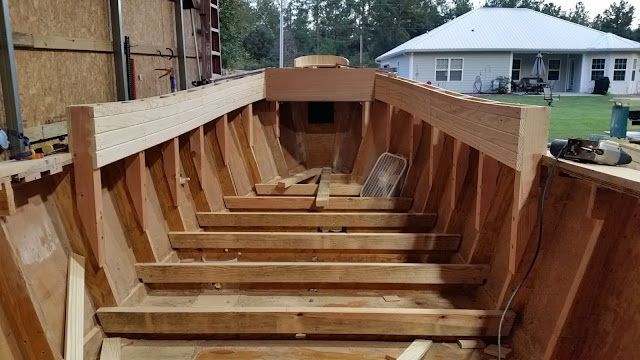Updating from September 2018... Bulwarks
My best buddy sidelined things for a little while, as life will, as we had to spend 14 weeks of surgery, rehab, revision surgery then more rehab to repair her knee. Her name is Gracie and shes a very special girl. She's the Nanny dog to my two granddaughters and a top-notch sock thief. It wasn't easy on any of us and we spent 3 months sleeping in the living room on an air mattress next to her crate as she very slowly got better. Thanks to the surgical center at Coastal Ortho and to Georgia and her wonderful crew at Fetch Canine for their focused rehab and the lovin' they gave Gracie.Bulwarks - Let's start with Stanchions... about mid September 2018
 Sometimes we get lucky. The local HD stocks Douglas Fir 4x4's. That's a big deal in Yellow Pine country. I would have taken Yellow Pine, love it, but treated would have been a tough chore to pick through. I milled these down to 3" x 3" because the frames are 1-1/2" and somehow I thought that it would be good that it was a multiple of that. Not sure why I did but it seemed right and thought it may pay off making things fit better later.
Sometimes we get lucky. The local HD stocks Douglas Fir 4x4's. That's a big deal in Yellow Pine country. I would have taken Yellow Pine, love it, but treated would have been a tough chore to pick through. I milled these down to 3" x 3" because the frames are 1-1/2" and somehow I thought that it would be good that it was a multiple of that. Not sure why I did but it seemed right and thought it may pay off making things fit better later. I basically squared the Bulwark stanchions off the floor timbers and marked the angle as they fell across the frames. I used lags to secure them. Ceramic coated lags that I'll slather the heads with epoxy before final paint if not buried behind other subsequent timbers. All of this under a canopy yet to be constructed.
I basically squared the Bulwark stanchions off the floor timbers and marked the angle as they fell across the frames. I used lags to secure them. Ceramic coated lags that I'll slather the heads with epoxy before final paint if not buried behind other subsequent timbers. All of this under a canopy yet to be constructed.
The scantlings are heavy I know. I intend that they be. This is a slow cruiser. She'll do hull speed and that's it. I have a 9.9 Suzuki Hi-Thrust (same displacement as the 20HP but choked down to a max 4500RPM) so I think that it'll do all it needs without much waste.
The bulwarks themselves are 3/4" pine that is sprung to the stanchions and screwed in place.
At this point I had lowered the floor and removed the raised floor timbers. Those are seen standing in one of the photos here.
The inside of the bulwark is lined with pine that has been chamfered and hot dip galv nailed in place. By the way... I used a DuoFast siding nail gun for this. I used it primarily because the DuoFast brand of hot dipped, ring-shanked coil nails are some of the best, most corrosion resistant gun nails I've ever used. I found this watching them weather (or not weather) for the past 10 years at our Rome farm before we moved. I thought... "why not?"
 At the fore end of the bulwark I decided to build a little curve into this. It actually evolved a little further (as you will see) as I started thinking about the boat's helm which I am building as far forward as I can for visibility.
At the fore end of the bulwark I decided to build a little curve into this. It actually evolved a little further (as you will see) as I started thinking about the boat's helm which I am building as far forward as I can for visibility.I also made a few "slack-belt" hand sanders to smooth out the curves that were basically built of segments, like barrel staves.
The inner ceiling, as the lining is sometimes called, stops about here for now. Benches will lay over these so I didn't want to waste material to just be covered back up.

























